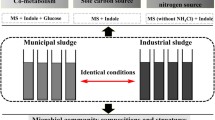Abstract
In the present study, mineralization of an aromaticN-heterocyclic molecule, indole, by microorganisms present in anaerobically digested sewage sludge was examined. The first step in indole mineralization was the formation of a hydroxylated intermediate, oxindole. The rate of transformation of indole to oxindole and its subsequent disappearance was dependent on the concentration of inoculum and indole and the incubation temperature. Methanogenesis appeared to be the dominant process in the mineralization of indole in 10% digested sludge even in the presence of high concentrations of sulfate. Enrichment of the digested sludge with sulfate as an electron acceptor allowed the isolation of a metabolically stable mixed culture of anaerobic bacteria which transformed indole to oxindole and acetate, and ultimately to methane and carbon dioxide. This mixed culture exhibited a predominance of sulfate-reducers over methanogens with more than 75% of the substrate mineralized to carbon dioxide. The investigation demonstrates that indole can be transformed by both methanogenic and sulfate-reducing microbial populations.
Similar content being viewed by others
References
Abram JW, Nedwell DB (1978) Hydrogen as a substrate for methanogenesis and sulfate reduction in anaerobic saltmarsh sediment. Arch Microbiol 117:93–97
Archer DB, Powell GE (1985) Dependence of specific growth rate of methanogenic mutualistic cocultures on the methanogen. Arch Microbiol 141:133–137
Bak F, Widdel F (1986) Anaerobic degradation of indolic compounds by sulfate-reducing enrichment cultures, and description ofDesulfobacterium indolicum gen. nov., sp. nov. Arch Microbiol 146:170–176
Balba MT, Evans WC (1980) Methanogenic fermentation of naturally occurring amino acids by a microbial consortium. Biochem Soc Trans 8:625–627
Berry DF, Francis AJ, Bollag JM (1987) Microbial metabolism of homocyclic and heterocyclic aromatic compounds under anaerobic conditions. Microbiol Rev 51:43–59
Berry DF, Madsen EL, Bollag JM (1987) Conversion of indole to oxindole under methanogenic conditions. Appl Environ Microbiol 53:180–182
Callely AG (1978) The microbial degradation of heterocyclic compounds. Prog Ind Microbiol 14:205–281
Dailey NS (1981) Process effuents: quantities and control technologies, Chapter 4. In: Braunstein HM, Copenhaver ED, Pfuderer HA (eds) Environmental, health and control aspects of coal conversion—an information overview, vol 1. Ann Arbor Science Publ. Inc., Ann Arbor, Michigan
Ensley BD, Ratzkin BJ, Osslund TD, Simon MJ, Wackett LP, Gibson DT (1983) Expression of naphthalene oxidation genes inEscherichia coli results in biosynthesis in indigo. Science 222:167–169
Ferry JG, Wolfe RS (1976) Anaerobic degradation of benzoate to methane by a microbial consortium. Arch Microbiol 107:33–40
Gilboa-Garber N (1971) Direct spectrophotometric determination of inorganic sulfide in biological materials and in other complex mixtures. Anal Biochem 43:129–133
Hawthorne SR, sievers RE (1984) Emission of organic air pollutants from shale oil wastewaters. Environ Sci Technol 18:483–490
Hungate RE (1969) A role tube method for the cultivation of strict anaerobes. In: Norris JR, Ribbons DW (eds) Methods in microbiology. Academic Press, London and New York, pp 117–132
Hungate RE (1985) Anaerobic biotransformation of organic matter. In: Leadbetter ER, Poindexter JR (eds), Plenum Press, New York, pp 89–96
Kaiser JP, Hanselmann KW (1982) Fermentative metabolism of substituted monoaromatic compounds by a bacterial community from anaerobic sediments. Arch Microbiol 133:185–194
King GM, Klug MJ (1980) sulfhydrolase activity in sediments of Wintergreen Lake, Kalamazoo County, Michigan. Appl Environ Microbiol 39:950–956
Lee MD, Thomas JM, Borden RC, Bedient PB, Ward CH, Wilson JE (1988) Biorestoration of aquifers contaminated with organic compounds. CRC Crit Rev Environ Cont 18:29–89
Lovely DR, Dwyer DF, Klug MJ (1982) Kinetic analysis of competition between sulfate reducers and methanogens for hydrogen in sediments. Appl Environ Microbiol 43:1371–1379
Madsen EL, Francis AJ, Bollag JM (1988) Environmental factors affecting indole metabolism under anaerobic conditions. Appl Environ Microbiol 54:74–78
Madsen EL, Bollag JM (1989) Pathway of indole metabolism by a denitrifying microbial community. Arch Microbiol 151:71–76
Mah RA, Ward DM, Baresi L, Glass TL (1977) Biogenesis of methane. Ann Rev Microbiol 31:309–341
Major dW, Mayfield CI, Barker JF (1988) Biotransformation of benezene by denitrification in aquifer sand. Groundwater 26:8–14
McInerney MJ, Bryant MP (1981) Review of methane fermentation fundamentals. In: Wise DL (ed) Fuel and gas production from biomass. Chemical Rubber Co. Press, West Palm Beach, Florida, pp 19–46
Miller TL, Wolin MJ (1974) A serum bottle modification of Hungate technique for cultivating obligate anaerobes. Appl Microbiol 27:985–987
Miwa H, Hiyama C, Yamamoto M (1985) High-performance liquid chromatography of short-and long-chain fatty acids as 2-nitrophenylhydrazides. J Chromatogr 321:165–174
Oremland RS, Taylor BF (1978) Sulfate reduction and methanogenesis in marine sediments. Geochim Cosmochim Acta 42:209–214
Senior E, Lindstrom EB, Banat IM, Nedwell DB (1982) Sulfate reduction and methanogenesis in the sediment of a saltmarsh on the east coast of United Kingdom. Appl Environ Microbiol 43:987–996
Traore AS, Fardeau ML, Hartchikian CH, LeGall J, Belaich JP (1983) Energetics of growth of a defined mixed culture ofDesulfovibrio vulgaris andMethanosarcina barkeri: Interspecies hydrogen transfer in batch and continuous cultures. Appl Environ Microbiol 46:1152–1156
Widdel F (1986) Sulfate-reducing bacteria and their ecological niches. In: Barnes EM, Mead GC (eds) Anaerobic bacteria in habitats other than man. Blackwell Scientific Publications, Oxford, pp 157–184
Wilkes DJ (1981) Animals: bioenvironmental effects. In: Braunstein HM, Copenhaver ED, Pfuderer HA (eds) Environmental, health and control aspects of coal conversion—an information overview, vol 2, Ann Arbor Science Publishers, Ann Arbor, Michigan, pp 1–163
Winfrey MR, Zeikus JG (1977) Effect of sulfate on carbon and electron flow during microbial methanogenesis in freshwater sediments. Appl Environ Microbiol 33:275–281
Winfrey MR, Marty DG, Bianchi AJM, Ward DM (1981) Vertical distribution of sulfate reduction, methane production, and bacteria in marine sediments. Geomicrobiol J 2:341–362
Author information
Authors and Affiliations
Rights and permissions
About this article
Cite this article
Shanker, R., Bollag, JM. Transformation of indole by methanogenic and sulfate-reducing microorganisms isolated from digested sludge. Microb Ecol 20, 171–183 (1990). https://doi.org/10.1007/BF02543875
Issue Date:
DOI: https://doi.org/10.1007/BF02543875




